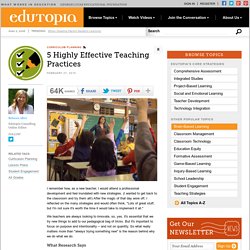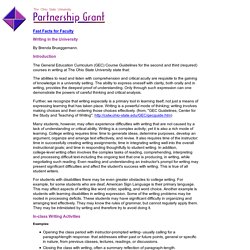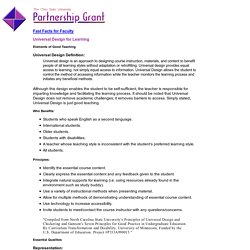

Multiple Intelligence.
Goals and Moves. Professional Development. Educator Resources. Jay Leno and Abstract Algebra. Physicists Seek To Lose The Lecture As Teaching Tool. The lecture is one of the oldest forms of education there is.

"Before printing someone would read the books to everybody who would copy them down," says Joe Redish, a physics professor at the University of Maryland. But lecturing has never been an effective teaching technique and now that information is everywhere, some say it's a waste of time. Indeed, physicists have the data to prove it. When Eric Mazur began teaching physics at Harvard, he started out teaching the same way he had been taught. "I sort of projected my own experience, my own vision of learning and teaching — which is what my instructors had done to me. He loved to lecture. "For a long while, I thought I was doing a really, really good job," he says. Why Ability Grouping Doesn't Work. The Big List of Class Discussion Strategies. Listen to this article as a podcast episode: Podcast: Play in new window | Download (Duration: 38:22 — 53.1MB) Subscribe: iTunes | Android | When I worked with student teachers on developing effective lesson plans, one thing I always asked them to revise was the phrase “We will discuss.”

We will discuss the video. We will discuss the story. We will discuss our results. Every time I saw it in a lesson plan, I would add a note: “What format will you use? The problem wasn’t them; in most of the classrooms where they’d sat as students, that’s exactly what a class discussion looked like. So here they are: 15 formats for structuring a class discussion to make it more engaging, more organized, more equitable, and more academically challenging. I’ve separated the strategies into three groups. Enjoy! Gallery Walk > a.k.a. Basic Structure: Stations or posters are set up around the classroom, on the walls or on tables. 5 Highly Effective Teaching Practices. I remember how, as a new teacher, I would attend a professional development and feel inundated with new strategies.

(I wanted to get back to the classroom and try them all!) After the magic of that day wore off, I reflected on the many strategies and would often think, "Lots of great stuff, but I'm not sure it's worth the time it would take to implement it all. " We teachers are always looking to innovate, so, yes, it's essential that we try new things to add to our pedagogical bag of tricks. But it's important to focus on purpose and intentionality -- and not on quantity. So what really matters more than "always trying something new" is the reason behind why we do what we do. What Research Says This leads me to educational researcher John Hattie, who wrote Visible Learning for Teachers: Maximizing Impact on Learning. Hattie has spent more than 15 years researching the influences on achievement of K-12 children. ADA:Fast Facts for Faculty - Writing in the University. Writing in the University By Brenda Brueggemann.

Introduction The General Education Curriculum (GEC) Course Guidelines for the second and third (required) courses in writing at The Ohio State University state that: The abilities to read and listen with comprehension and critical acuity are requisite to the gaining of knowledge in a university setting. The ability to express oneself with clarity, both orally and in writing, provides the deepest proof of understanding. Further, we recognize that writing especially is a primary tool in learning itself, not just a means of expressing learning that has taken place. ADA: Partnership Grant - Fast Facts for Faculty. Guided Notes Improving the Effectiveness of Your Lectures Developed by William L.

Heward The Ohio State University Partnership Grant Improving the Quality of Education for Students with Disabilities. What Are Guided Notes? Guided notes are instructor-prepared handouts that provide all students with background information and standard cues with specific spaces to write key facts, concepts, and/or relationships during the lecture. Some Pros and Cons of the Lecture Method Lecturing is one of the most widely used teaching methods in higher education. Advantages of lecturing. Although some educators consider the lecture method outdated and ineffective, it offers several advantages and reasons for its continued use (Barbetta & Scaruppa, 1995; Michael, 1994).
ADA: Fast Facts for Faculty - Universal Design. Elements of Good Teaching Universal Design Definition: Universal design is an approach to designing course instruction, materials, and content to benefit people of all learning styles without adaptation or retrofitting.

Universal design provides equal access to learning, not simply equal access to information. Universal Design allows the student to control the method of accessing information while the teacher monitors the learning process and initiates any beneficial methods. Although this design enables the student to be self-sufficient, the teacher is responsible for imparting knowledge and facilitating the learning process. Who Benefits: Students who speak English as a second language. Principles: Identify the essential course content. "Compiled from North Carolina State University's Principles of Universal Design and Chickering and Gamson's Seven Principles for Good Practice in Undergraduate Education.
Guided Notes Fact Sheet.